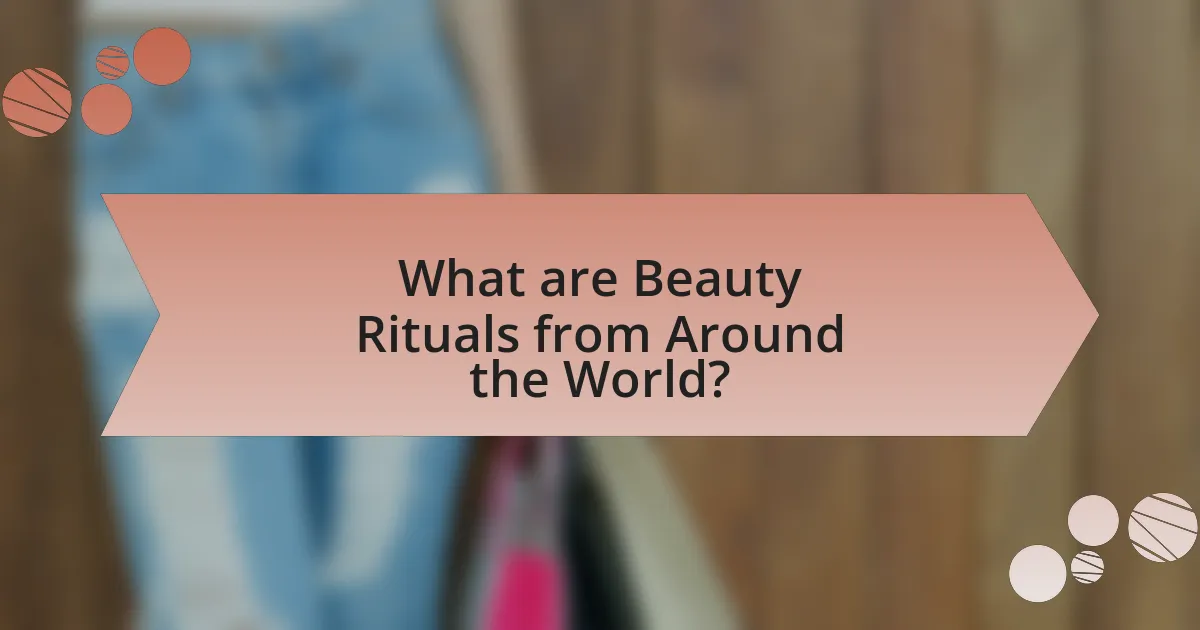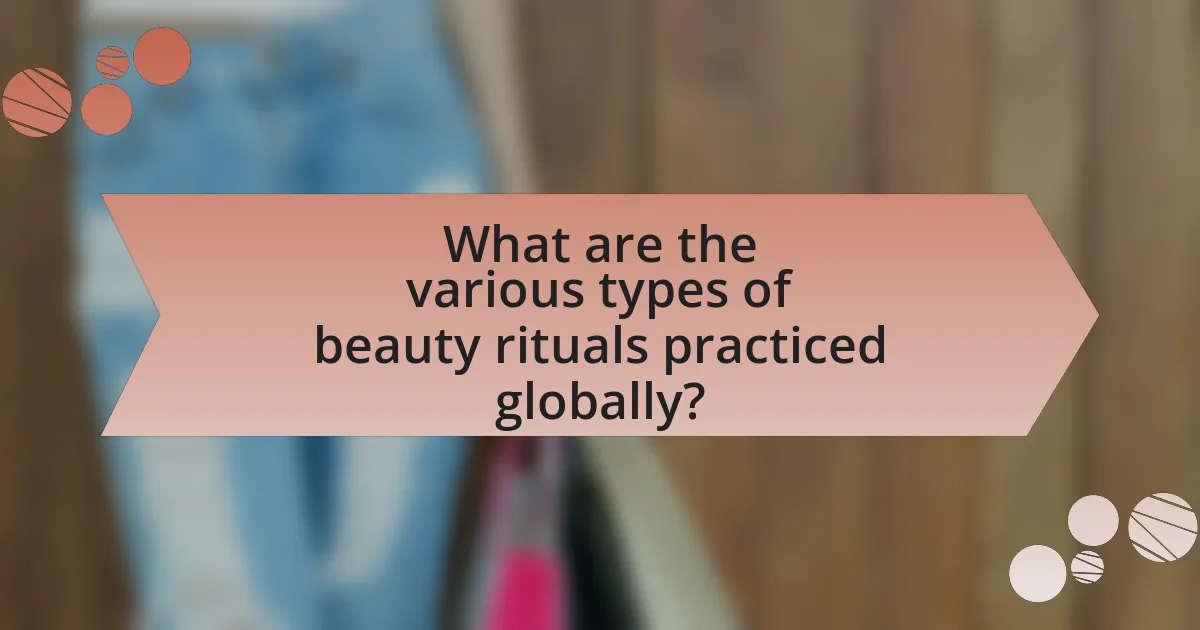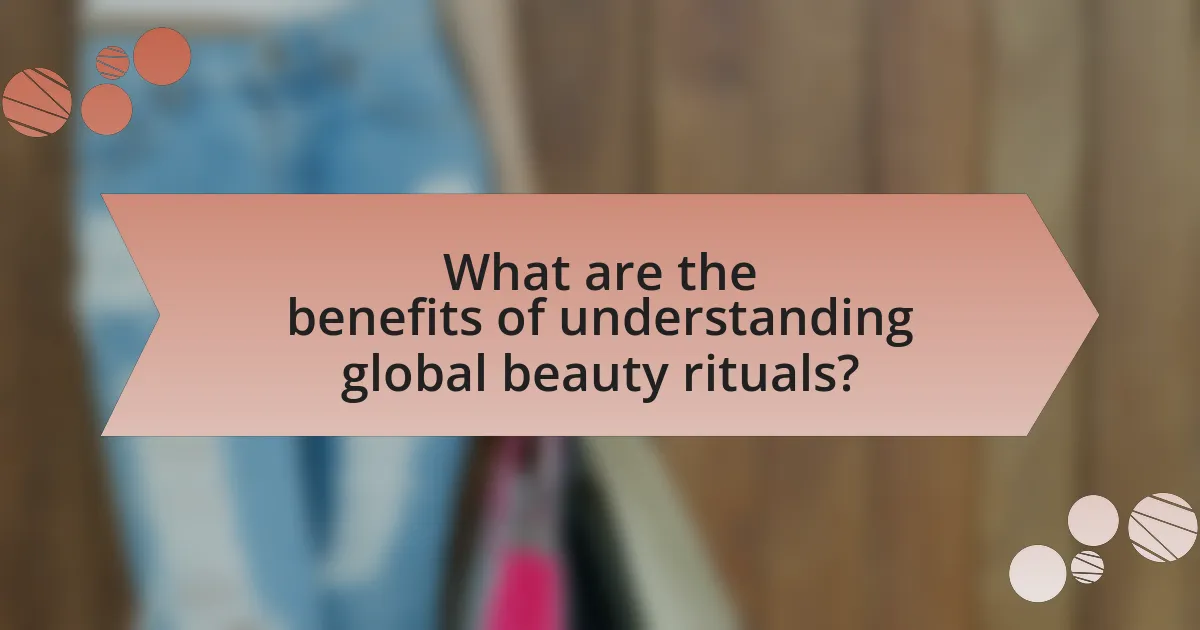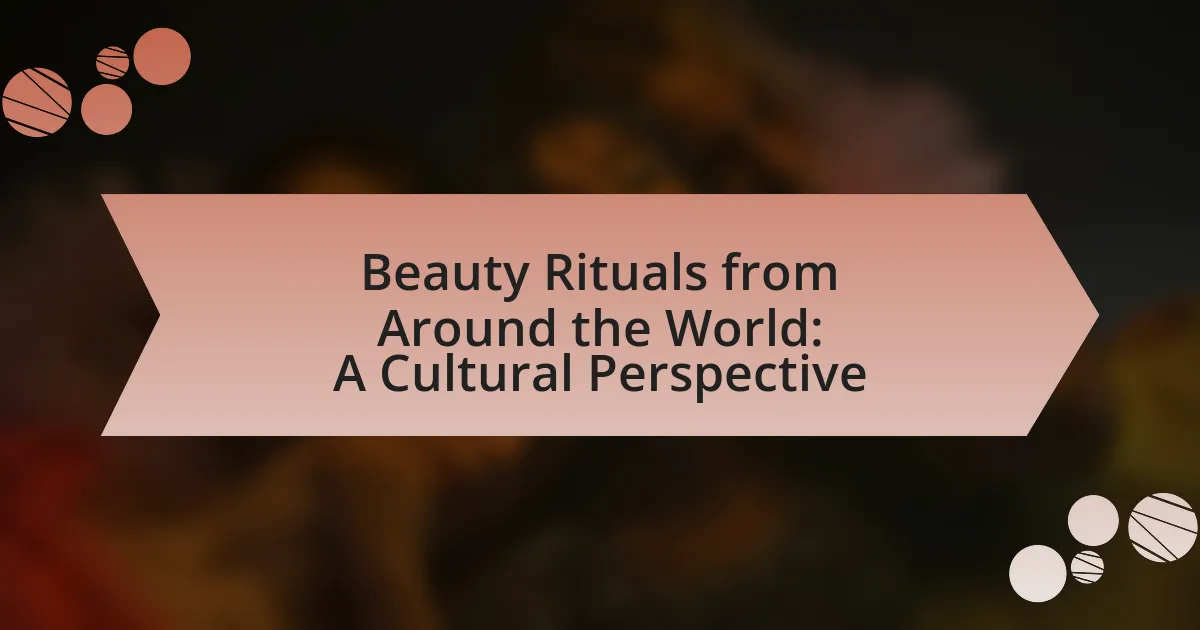Beauty rituals from around the world represent a diverse array of practices aimed at enhancing physical appearance and promoting well-being, deeply influenced by cultural backgrounds and historical events. The article explores various global beauty rituals, such as the use of rice water in Japan, turmeric masks in India, and multi-step skincare routines in South Korea, highlighting their cultural significance and the natural ingredients involved. It also examines how these rituals reflect societal values, contribute to cultural heritage, and adapt to modern trends, emphasizing the importance of understanding these practices for fostering cultural appreciation and informing personal beauty routines. Additionally, the article addresses common misconceptions about beauty rituals and their effectiveness across different cultures.

What are Beauty Rituals from Around the World?
Beauty rituals from around the world encompass diverse practices aimed at enhancing physical appearance and promoting well-being. For instance, in Japan, the use of rice water as a facial rinse is a traditional method believed to improve skin texture and clarity, a practice rooted in centuries of cultural heritage. In India, the application of turmeric masks is common, as turmeric is known for its anti-inflammatory and antibacterial properties, contributing to a radiant complexion. Similarly, in South Korea, the multi-step skincare routine, which includes cleansing, toning, and moisturizing, reflects a cultural emphasis on skin health and beauty, supported by a thriving beauty industry. These rituals not only highlight the unique cultural values associated with beauty but also demonstrate the global diversity in approaches to skincare and self-care.
How do cultural backgrounds influence beauty rituals?
Cultural backgrounds significantly influence beauty rituals by shaping the practices, products, and values associated with beauty in different societies. For instance, in many Asian cultures, skincare routines emphasize hydration and sun protection, reflecting a cultural preference for fair skin, which is often associated with beauty and social status. In contrast, African beauty rituals may focus on the use of natural oils and butters, highlighting the importance of skin nourishment and protection against harsh climates. Historical practices, such as the use of kohl in ancient Egypt for both aesthetic and protective purposes, further illustrate how cultural beliefs and environmental factors dictate beauty standards and rituals. These variations underscore the deep connection between cultural identity and beauty practices, demonstrating that beauty is not a universal concept but rather a reflection of diverse cultural values and traditions.
What are some common themes in global beauty practices?
Common themes in global beauty practices include the use of natural ingredients, cultural significance, and rituals that promote well-being. Many cultures emphasize the importance of using locally sourced, natural materials such as oils, herbs, and minerals, which are believed to enhance beauty while being gentle on the skin. For instance, the use of coconut oil in South Asian beauty routines and shea butter in West African practices highlights this theme. Additionally, beauty practices often carry cultural significance, reflecting societal values and traditions, such as the use of henna in Indian weddings or the significance of facial tattoos in Maori culture. Lastly, many beauty rituals incorporate elements of mindfulness and self-care, promoting not only physical beauty but also mental and emotional well-being, as seen in practices like Japanese skincare routines that emphasize relaxation and self-reflection.
How do historical events shape contemporary beauty rituals?
Historical events significantly shape contemporary beauty rituals by influencing cultural norms, practices, and the availability of beauty products. For instance, the rise of the feminist movement in the 1960s challenged traditional beauty standards, leading to a broader acceptance of diverse body types and natural beauty, which is reflected in today’s beauty rituals that emphasize inclusivity and self-expression. Additionally, the globalization of beauty standards, driven by historical trade routes and colonialism, has resulted in the blending of various cultural practices, such as the incorporation of Ayurvedic principles in Western skincare routines. These historical influences are evident in the popularity of products like natural oils and herbal remedies, which have roots in ancient practices.
Why are beauty rituals important in different cultures?
Beauty rituals are important in different cultures because they serve as expressions of identity, tradition, and social values. These rituals often reflect cultural heritage and can signify social status, community belonging, or personal milestones. For instance, in many African cultures, body adornment practices, such as scarification or the use of intricate jewelry, are deeply rooted in historical significance and communal identity. Similarly, in Japan, the practice of applying traditional makeup for geisha is not only an art form but also a representation of cultural history and societal roles. Such rituals reinforce community bonds and convey messages about beauty standards, thus playing a crucial role in cultural continuity and individual self-expression.
What role do beauty rituals play in social identity?
Beauty rituals significantly contribute to social identity by serving as markers of cultural belonging and personal expression. These rituals often reflect societal norms, values, and expectations, allowing individuals to align themselves with specific groups or communities. For example, in many cultures, practices such as skin care routines, hair styling, and makeup application are not only personal choices but also signify adherence to cultural standards of beauty, which can influence social status and acceptance. Research indicates that beauty rituals can enhance self-esteem and foster a sense of community, as individuals engage in shared practices that reinforce their identity within a cultural context.
How do beauty rituals contribute to cultural heritage?
Beauty rituals contribute to cultural heritage by preserving traditional practices and values that reflect the identity of a community. These rituals often incorporate local ingredients, techniques, and symbolism, which are passed down through generations, thus maintaining a connection to ancestral customs. For example, the use of henna in South Asian weddings not only serves a beautifying purpose but also signifies cultural significance and social bonding. Such practices are documented in various anthropological studies, highlighting their role in reinforcing community ties and cultural continuity.

What are the various types of beauty rituals practiced globally?
Various types of beauty rituals practiced globally include traditional practices such as Japanese skincare routines, Indian Ayurvedic treatments, and Brazilian body treatments. Japanese beauty rituals often emphasize layering products for hydration and protection, while Indian rituals may incorporate herbal ingredients and massage techniques to promote wellness and beauty. Brazilian beauty practices frequently focus on body hair removal and skin smoothing treatments, reflecting cultural preferences. These rituals are rooted in cultural heritage and often utilize locally sourced ingredients, showcasing the diversity of beauty standards and practices worldwide.
How do beauty rituals differ across continents?
Beauty rituals differ significantly across continents due to cultural, historical, and environmental factors. In Asia, for instance, skincare routines often emphasize hydration and sun protection, with countries like South Korea popularizing multi-step regimens that include essences and sheet masks. In contrast, African beauty rituals frequently incorporate natural ingredients like shea butter and oils, reflecting a deep connection to local flora and traditional practices.
In Europe, beauty rituals can vary widely; for example, French beauty often focuses on minimalism and natural looks, while Scandinavian countries prioritize sustainability and eco-friendly products. North American beauty rituals tend to blend influences from various cultures, emphasizing both skincare and makeup, with a growing trend towards inclusivity and diversity in product offerings.
These differences are rooted in each continent’s unique cultural heritage, available resources, and societal values, illustrating how beauty is perceived and practiced globally.
What unique beauty practices are found in Asia?
Unique beauty practices found in Asia include the use of rice water for skin and hair care, which is prevalent in countries like Japan and Korea. This practice is rooted in historical traditions, as rice water is rich in vitamins and minerals that promote skin elasticity and shine. Additionally, the use of herbal pastes, such as turmeric and neem in India, is common for their anti-inflammatory and antibacterial properties, enhancing skin health. In South Korea, the multi-step skincare routine, often comprising up to ten steps, emphasizes hydration and protection, showcasing a cultural commitment to skincare. These practices are supported by cultural beliefs in natural ingredients and holistic wellness, reflecting the diverse approaches to beauty across the continent.
What are the traditional beauty rituals in Africa?
Traditional beauty rituals in Africa include the use of natural ingredients such as shea butter, oils, and herbs for skin and hair care. For instance, shea butter is widely used across West Africa for moisturizing and protecting the skin, while various oils, like coconut and argan oil, are employed for hair nourishment and styling. Additionally, many African cultures incorporate rituals involving the application of clay masks for cleansing and detoxifying the skin, as seen in the Himba tribe of Namibia, who use otjize, a mixture of butterfat and ochre, to protect their skin from the harsh sun. These practices are deeply rooted in cultural heritage and often passed down through generations, reflecting the significance of beauty in social and spiritual contexts.
What modern adaptations have emerged in beauty rituals?
Modern adaptations in beauty rituals include the integration of technology, such as skincare apps and virtual consultations, which enhance personalized beauty routines. Additionally, there is a growing trend towards sustainable and clean beauty products, reflecting consumer demand for environmentally friendly options. The rise of social media platforms has also influenced beauty rituals, as users share tutorials and product recommendations, leading to the popularity of DIY beauty treatments. These adaptations are supported by market research indicating that the global clean beauty market is projected to reach $22 billion by 2024, highlighting the shift towards conscious consumerism in beauty practices.
How are traditional rituals being integrated into contemporary beauty standards?
Traditional rituals are being integrated into contemporary beauty standards through the incorporation of natural ingredients and holistic practices that emphasize wellness and self-care. For instance, many modern beauty brands now utilize traditional ingredients like turmeric, honey, and coconut oil, which have been used in various cultures for centuries due to their beneficial properties for skin and hair. Additionally, practices such as facial massage techniques from East Asian cultures and the use of herbal remedies from Indigenous traditions are gaining popularity in contemporary beauty routines. This integration reflects a growing consumer preference for authenticity and sustainability in beauty products, as evidenced by the rise of brands that highlight their cultural heritage and traditional methods in marketing.
What influence does globalization have on local beauty practices?
Globalization significantly influences local beauty practices by introducing diverse beauty standards and products from around the world. This exposure leads to the blending of traditional and modern beauty rituals, as seen in the increasing popularity of Western cosmetics in non-Western cultures. For instance, the rise of social media platforms has facilitated the global exchange of beauty trends, allowing local practitioners to adopt and adapt these influences while maintaining their cultural identity. Research indicates that 70% of consumers in emerging markets are influenced by global beauty trends, highlighting the impact of globalization on local practices.

What are the benefits of understanding global beauty rituals?
Understanding global beauty rituals enhances cultural appreciation and promotes inclusivity. By exploring diverse practices, individuals gain insights into the values and traditions of different societies, fostering respect and empathy. For instance, the use of natural ingredients in African beauty rituals highlights a connection to nature and sustainability, while Japanese skincare routines emphasize meticulous care and discipline. Such knowledge can also inspire innovation in beauty products and practices, as seen in the rising popularity of K-beauty trends worldwide. Ultimately, recognizing these rituals enriches personal beauty practices and encourages a broader dialogue about beauty standards across cultures.
How can knowledge of beauty rituals enhance cultural appreciation?
Knowledge of beauty rituals enhances cultural appreciation by providing insights into the values, traditions, and social norms of different societies. Understanding these rituals allows individuals to recognize the significance of beauty practices in cultural identity and expression. For example, the use of kohl in Middle Eastern cultures is not merely for aesthetic purposes but also carries historical and cultural meanings, reflecting social status and heritage. This knowledge fosters respect and empathy towards diverse cultural practices, promoting a deeper connection and appreciation for the richness of global traditions.
What insights can beauty rituals provide about societal values?
Beauty rituals reflect societal values by illustrating cultural norms, ideals of beauty, and social hierarchies. For example, in many cultures, rituals involving skincare or adornment signify the importance placed on physical appearance and self-care, which can indicate a society’s emphasis on individualism or self-expression. Additionally, the materials and techniques used in these rituals often reveal economic factors and access to resources, highlighting disparities in wealth and privilege. Historical practices, such as the use of kohl in ancient Egypt, not only served aesthetic purposes but also indicated social status and religious beliefs, demonstrating how beauty rituals can encapsulate broader societal structures and values.
How can beauty rituals inform personal beauty practices?
Beauty rituals can inform personal beauty practices by providing diverse techniques and philosophies that enhance individual routines. For example, the use of natural ingredients in traditional beauty rituals, such as coconut oil in South Asian cultures or honey in ancient Egyptian practices, demonstrates effective methods for skincare that can be integrated into modern routines. These rituals often emphasize holistic approaches, focusing on both physical appearance and mental well-being, which can lead to more mindful beauty practices. Additionally, cultural significance attached to certain rituals can inspire individuals to adopt practices that resonate with their identity, thereby enriching their personal beauty regimen.
What practical tips can be derived from global beauty rituals?
Practical tips derived from global beauty rituals include the use of natural ingredients, such as coconut oil for moisturizing from South Asia, and the application of rice water for hair shine, popular in East Asia. These rituals emphasize the importance of hydration and nourishment, as seen in the use of honey and yogurt in Middle Eastern skincare for their antibacterial properties. Additionally, the practice of facial massage, common in various cultures, promotes circulation and enhances skin elasticity. These tips are validated by the widespread adoption of these ingredients and techniques across different cultures, highlighting their effectiveness in beauty routines.
How can one incorporate elements of different beauty rituals into daily routines?
One can incorporate elements of different beauty rituals into daily routines by selecting specific practices that resonate with personal preferences and lifestyle. For instance, integrating a Japanese skincare layering technique, which emphasizes multiple steps for hydration, can enhance moisture retention in the skin. Additionally, adopting the use of natural ingredients, such as coconut oil from Indian beauty rituals for hair care, can improve hair health. Research indicates that the ritualistic aspect of beauty routines can enhance psychological well-being, as seen in a study published in the Journal of Cosmetic Dermatology, which highlights the positive effects of self-care practices on mental health. By blending these diverse rituals, individuals can create a personalized beauty regimen that reflects cultural richness while promoting overall wellness.
What are some common misconceptions about beauty rituals worldwide?
Common misconceptions about beauty rituals worldwide include the belief that all beauty practices are universally effective and that they stem solely from cultural traditions. Many people assume that beauty rituals, such as the use of specific oils or masks, will yield the same results regardless of individual skin types or environmental factors. Additionally, there is a misconception that these rituals are purely superficial, ignoring their historical and cultural significance. For instance, the use of rice water in East Asian beauty routines is often seen merely as a trend, while it has deep roots in tradition and is valued for its nourishing properties. Furthermore, some believe that Western beauty standards dominate globally, overshadowing the diverse and rich beauty practices found in various cultures, such as the use of henna in South Asia or the emphasis on natural ingredients in African beauty rituals.
